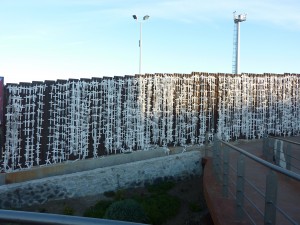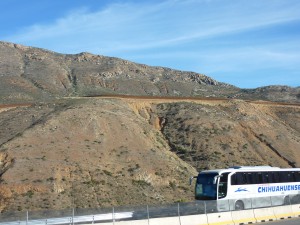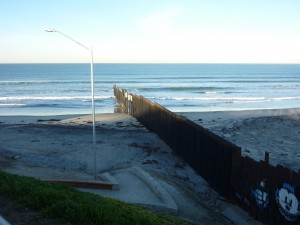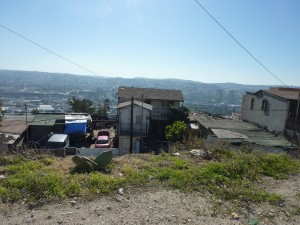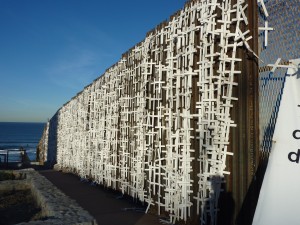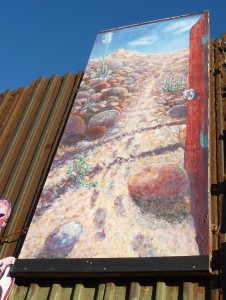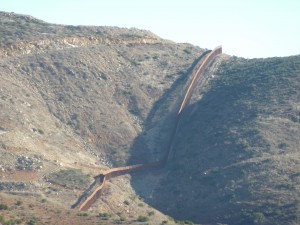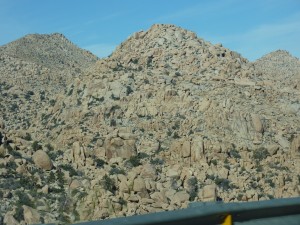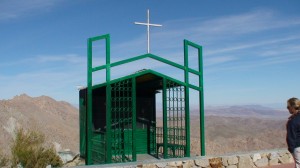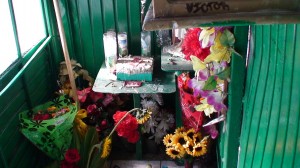LA RUMOROSA
Posted December 6 ’10Last week I went down to Mexico in search of Violeta Sanchez. She was a minor character in Point Dume who is going to play a major part in my new novel. Violeta was Felix Duarte’s fiancée whom he left behind when he agreed to work for a Mexican drug cartel that was growing pot on the public lands in Malibu. Felix said he would be gone for five months, and promised to come back with enough money so they could marry and begin a new life. But he never returned. Violeta waits for him, dreaming of their future, and when she realizes he isn’t coming back she goes to look for him.
It is harder than ever to enter this country if you are an undocumented young Mexican woman. The United States has sealed our borders in most of the urban areas thus funneling people into the harshest desert and mountain terrains. Thousands of migrants have died on U.S. soil as a result of exposure to extreme heat or cold. Crossing the border illegally is a dangerous and expensive journey. Someone like Violeta would have to scrap together five or six thousand dollars to pay a Coyote, or “Guia”, to bring her across and there is no guarantee that she will make it.
A woman like Violeta would probably board a bus in her town or village and ride for hours or days to a staging area in one of the border cities. There she would seek cheap shelter in a flophouse until she could find a guide to bring her across. All migrants are vulnerable, crossing into the U.S. is very dangerous, but women are particularly at risk. It is common knowledge that women are routinely raped, especially women traveling alone. Typically someone like Violeta would visit a pharmacist for contraception, knowing that she would probably be violated one or more times during the crossing. She wouldn’t want to risk a pregnancy. And because birth control is a sin in the eyes of the Catholic Church, she would probably leave the pharmacy and then find a priest who would absolve her of her sin. “Rape is part of the price of admission” is a phrase I have heard countless times. Most women know that and there is nothing they can do to protect themselves from attack. They have no choice but to endure and hope that they aren’t too badly assaulted.
It is hard for me to imagine the extreme desperation that would drive someone to leave their loved ones, home and family, to risk their lives and dignity, and cross into a hostile country where they are so completely unwanted. I felt I had to talk to migrants who had made the journey, look into the eyes of women who had walked the path that Violeta is going to take. And so I asked my friend John Carlos Frey, a documentary filmmaker whose work has so brilliantly illustrated the complexities of these problems, to take me along as he traveled the U.S./Mexico border and interviewed women and men in the shelters of Tijuana and Ensenada.
We crossed into Mexico at the San Ysidro gate in Tijuana. The city is traffic-choked and vaguely chaotic but with the exception of a couple of truckloads of military men in desert camouflage, wearing black face masks to obscure their identities and carrying automatic weapons, and a police officer on every corner, I saw little evidence of the drug wars.
We drove into one of the hillside colonias (neighborhoods) and visited a shelter that catered to women and children. John interviewed several women and we listened to many versions of the same heartbreaking story. Abuse and desperation were the themes of each and every narrative but the strength and courage of the people I met was absolutely remarkable. Then we drove down to Ensenada to another shelter that helps families and interviewed a man who had attempted to cross seven times in the last few months. All of these people had suffered a great deal but not one of them viewed themselves as a victim. There was incredible resilience and determination, especially amongst the women. Each and every one of them was going to try again. They all believed that they would make it, eventually.
The next morning we got up early and drove from Ensenada back to Tijuana. I wanted to look at the memorial on the Mexican border that commemorates migrants who have died while crossing. There are over five thousand crosses on this section of the barrier and a list with names of those who have perished. It is a powerful, heartbreaking work of art. Next to the memorial hung a painting of a doorway that opened onto a boulder-strewn wilderness. John explained that it was a painting of La Rumorosa. The message was clear; if you wanted to travel across the border, the best way was over those mountains. I asked him to take me there.
We drove through the mountains to Tecate. The border wall has cut an ugly scar in this beautiful wilderness. I couldn’t help but think how pointless it was to spend all that money on a useless wilderness boundary that could be so easily breached.
We traveled higher into the mountains. Every few miles there were water stations where migrants could fill their bottles before heading out into the harsh terrain. I was surprised by the number of stations; it seemed we passed one every couple of miles. And then we arrived in the magnificent area known as La Rumorosa and I knew that this was where Violeta would cross.
There are places in the world that speak to me, places of such intense beauty that my spirit literally soars. These areas feel familiar and give me a great sense of peace. Southeast Utah and the terrain around Dark Canyon is one. Grand Gulch is another. I try to visit often, hike and camp in remote wild lands. Spending time in those incredible landscapes is one of the great joys of my life. When I came around the corner on that winding Mexican road and saw the ragged and rocky-mountains of Rumorosa I knew that I’d found a new place of deep significance. It was immediately familiar and important to me in its harsh beauty and I knew that it was here that Violeta would begin her journey.
We drove in silence, awestruck by the desolate beauty, then came around yet another corner and found a roadside shine to Saint Judas Tadeo. He is a Saint who offers help to those in desperate need. There were flowers and the water station was full. We went inside and saw new candles burning; someone had passed by recently.
This was clearly an important place for those who risked their lives to cross the border, a place of worship and prayer. I could feel the people who had passed here before me and I saw the evidence of their offerings. I felt their hope and their fear. There were fresh flowers everywhere. Often people will bring pictures of their loved ones, or pictures of themselves, and ask the saint to protect them and grant them safe passage. There were photographs in this shrine of small children. And pinned to one of the offerings was a picture of a handsome young man who looked exactly like my character, Felix Duarte. I felt that Violeta had been here and was guiding me forward. I could feel her strength and spirit. I just hope I can do her story justice.

